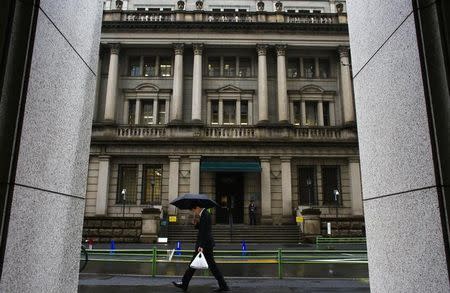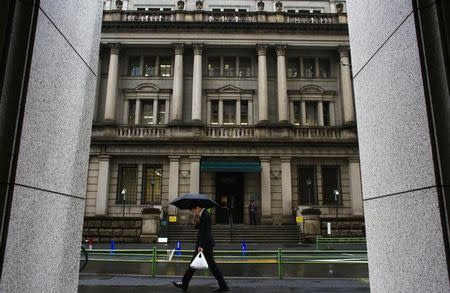OECD says BOJ has done enough, warns of QQE risks
By Leika Kihara and Stanley White
TOKYO (Reuters) - Japan must be mindful of the risks of its massive monetary stimulus and speed up much-needed structural reforms to revive the economy, the OECD said on Wednesday, warning of delays in their implementation.
Prime Minister Shinzo Abe's policies to revive the economy have been dubbed 'Abenomics', and the OECD report pointed to the mixed results of a strategy dependent on "three arrows" - massive monetary expansion, fiscal stimulus and structural reform.
OECD Secretary-General Angel Gurria said that while the Bank of Japan's stimulus - dubbed "quantitative and qualitative easing" (QQE) - cut borrowing costs and helped boost the economy, there were limits to what monetary policy can do.
"The first arrow is working, but there are limits," Gurria told reporters after issuing a report on recommendations for Japan, suggesting that no additional monetary easing was necessary for the time being.
"Structural reforms are not in the hands of central banks."
The OECD also urged Japan to boost labour productivity and remove trade barriers, stressing that the structural reforms that make up the "third arrow" of Abenomics have lagged the first two arrows of monetary and fiscal stimulus.
"The third arrow of Abenomics is its most crucial component, without which the unprecedented monetary expansion and the fiscal effort will not succeed in putting Japan on a path to faster growth and fiscal sustainability," it said.
On the weak yen, Gurria urged Japanese firms to use the current window of opportunity to export as much as possible since the yen will rebound once economic growth picks up pace.
"Over the medium to long term, if Japan is successful (in reviving the economy) the yen will strengthen."
LAGGING THIRD ARROW
In the report, the OECD welcomed last October's surprise expansion of QQE, saying the move and Abe's decision to delay a sales tax hike should sustain inflation expectations and "facilitate a definitive exit from deflation."
But it warned that the sheer size of the BOJ's purchases may disrupt the bond market and fuel asset price bubbles, acknowledging concerns held by QQE sceptics that the cost of the radical stimulus may outweigh the benefits.
Without a credible plan to curb its huge public debt, Japan may face a bond market sell-off that could hit banks with huge bond holdings, the report said.
"The recent expansion of QQE prompted concerns that the BOJ is being forced to monetise government debt, raising the risk of sustained yen depreciation and a run-up in interest rates that could undermine the financing of government deficits," it said.
In its upgraded forecasts, the OECD expects Japan's economy to grow 1.0 percent this year, up from 0.8 percent foreseen in November, and 1.4 percent in 2016, up from 1.0 percent, reflecting expectations for stronger business investment.
The BOJ deployed QQE in 2013 and now pledges to increase base money at an annual pace of 80 trillion yen (453 billion pounds) in order to hit 2 percent inflation around the year ending in March 2016.
(Additional reporting by Tetsushi Kajimoto; Editing by Simon Cameron-Moore)





